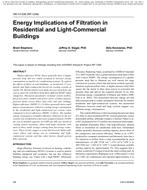Description
This paper is based on findings resulting from ASHRAE Research Project RP-1299.
Higher-efficiency HVAC filters generally have a higher pressure drop and are widely assumed to increase energy consumption in smaller air conditioning systems. To explore the effects of filters in real buildings, we monitored 17 residential and light-commercial forced air cooling systems in Austin, TX. Measurements were made once per month for one year at each site with filters from three different MERV range categories. Measured parameters included system airflow, fan power draw, outdoor unit power draw, cooling capacity, pressure drops across filters and coils, and duct leakage. Higher-efficiency (MERV 11-12) filters generally had a small impact on parameters related to cooling energy consumption in the residential and light-commercial test systems when compared to lower-efficiency (MERV 2) filters. The median energy consequence of higher-efficiency filtration in the test systems was estimated as a decrease of approximately 16 kWh per ton of nominal capacity (4.6 kWh per kW) per month of cooling season operation, albeit with large variation, with most of these small savings coming from fan energy reductions. These results suggest a weak link between higher-efficiency filters and energy use in residential and lightcommercial systems and that other factors should govern filter selection.
Units: Dual
Citation: ASHRAE Transactions, Vol. 116, pt. 1, Orlando 2010
Product Details
- Published:
- 2010
- Number of Pages:
- 12
- File Size:
- 1 file , 780 KB
- Product Code(s):
- D-OR-10-038




